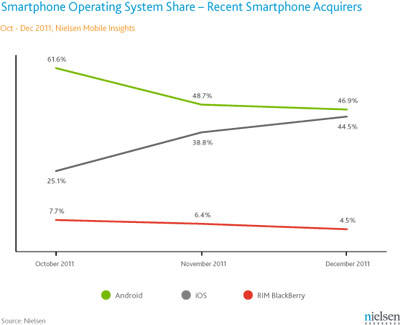The iPhone’s comeback and the power of carrier distribution
 Survey data from Nielsen suggests that Apple’s iPhone almost closed the gap with Google Android in December, as far as new smartphone purchases go. Assuming it’s accurate, this says as much about the value of carrier distribution as it says about anything else.
Survey data from Nielsen suggests that Apple’s iPhone almost closed the gap with Google Android in December, as far as new smartphone purchases go. Assuming it’s accurate, this says as much about the value of carrier distribution as it says about anything else.
Yes, it’s important that the new iPhone 4S launched, giving people closure that their new phone purchase wouldn’t be obsolete in a couple of months. (Although that never seems to stop Android buyers.) Plus cheaper versions of the iPhone 4 and 3GS surely helped.
But I’d say the most important thing is that this is the first time that a brand new iPhone was available at the top three carriers at once — Verizon Wireless, AT&T, and Sprint. The vast majority of new phones in the U.S. are still sold through carriers, so it’s important to be distributed through as many of the major operators as possible. Perhaps Apple could have beaten Android in December had the iPhone 4S been available at T-Mobile.
Justing by their advertising, Verizon and AT&T are still more interested in pushing their new 4G/LTE networks and devices than anything else. So I wouldn’t be surprised if Apple’s share dips again ahead of this year’s new iPhone launch (which should support LTE, if Apple is happy with size/performance). And then there is the great unknown of Windows Phone 7. (So far, sales are not impressive at all.)
But the iPhone’s comeback sure seems to suggest that Android’s “dominance” has been driven more by carriers than by the product.
Also: Actually, iPhone users tend to be richer and better educated than Android users

Check out my new site: The New Consumer, a publication about how and why people spend their time and money.

